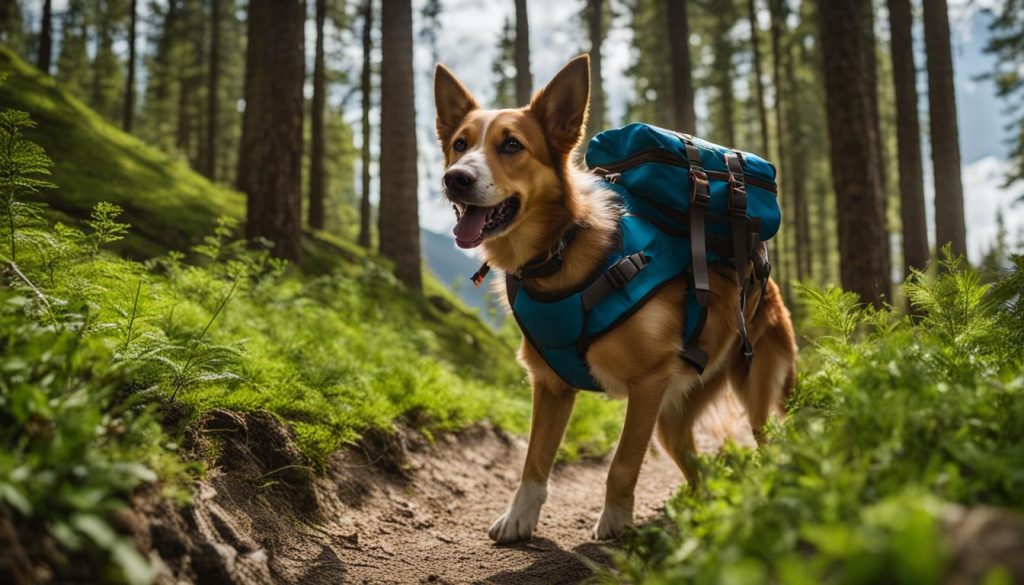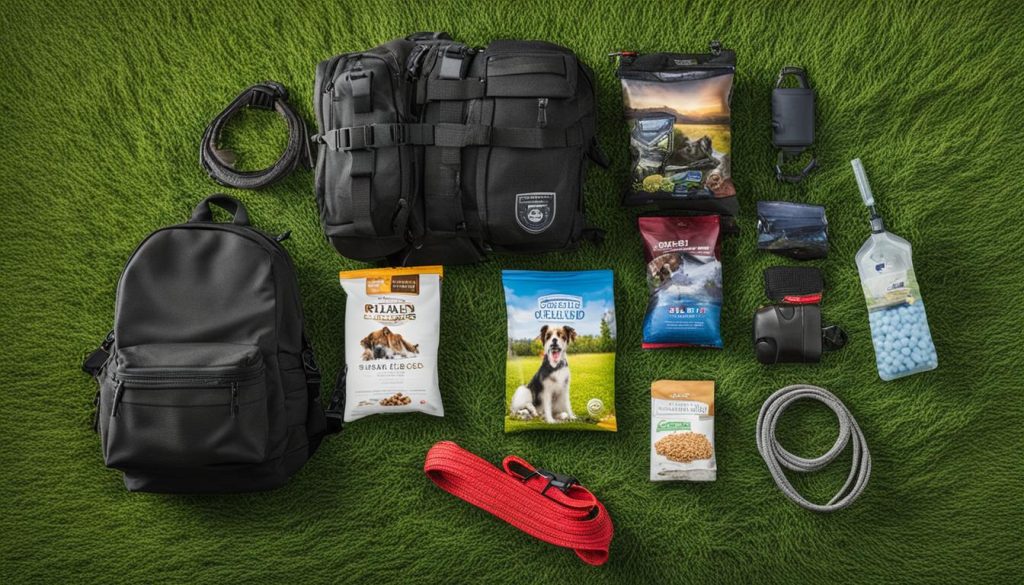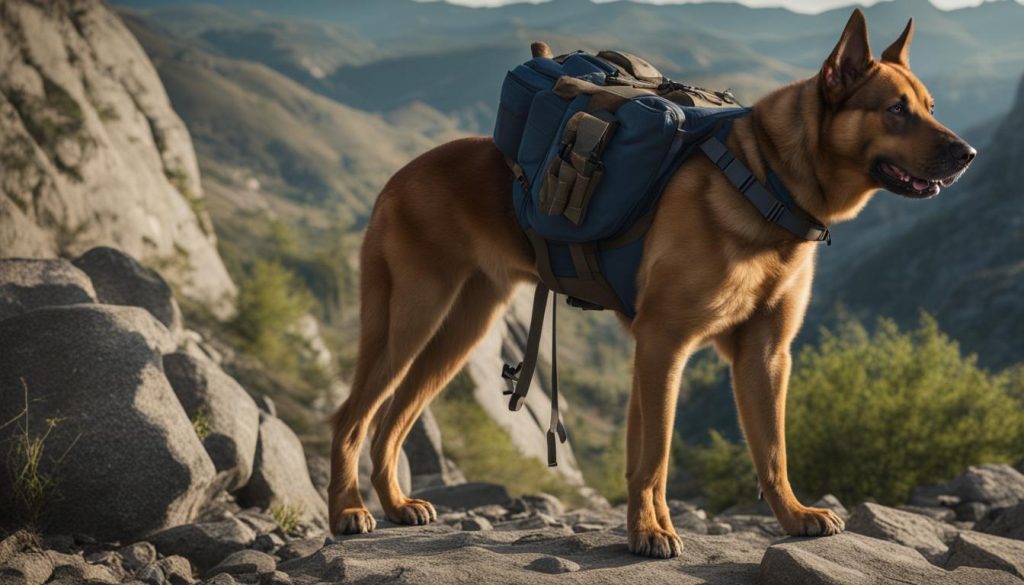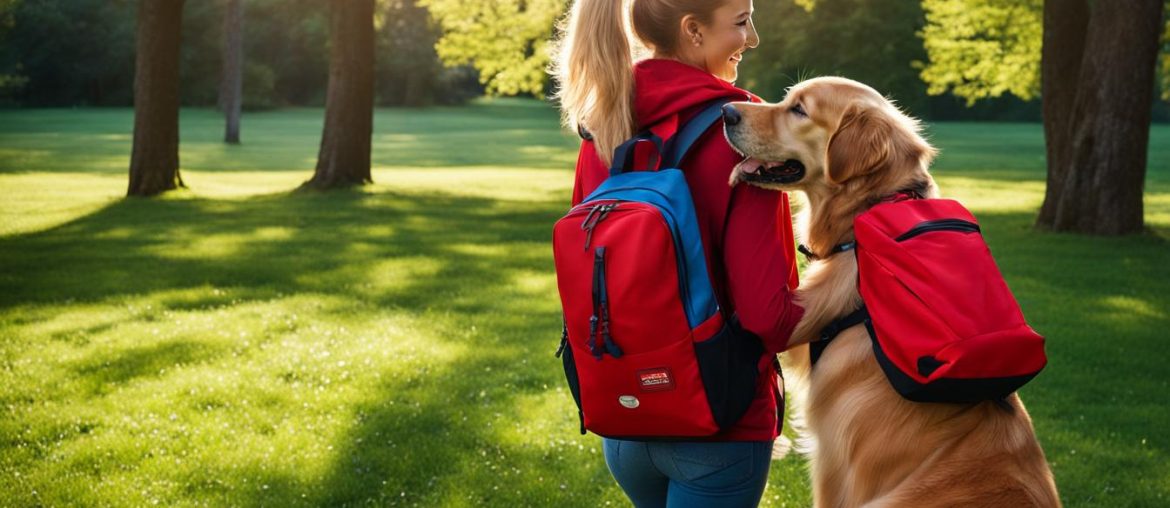Training your dog to wear a dog backpack can make hikes more enjoyable and hassle-free for both you and your dog. Dogs are naturally inclined to carry things, and teaching them to wear a backpack not only gives them a job to do but also helps keep them focused during walks. Here are the steps to get your dog comfortable with wearing a backpack and some tips for positive reinforcement in dog backpack training.
Key Takeaways:
- Train Your Dog to Wear a Dog Backpack
- Dog backpack training
- Teaching your dog to wear a backpack
- Positive reinforcement dog backpack training
Why Train Your Dog to Carry a Backpack?
Training your dog to carry a backpack during walks and hikes can offer numerous benefits for both you and your furry companion. Here are some of the advantages of teaching your dog to wear a backpack:
- Convenience: When your dog carries a backpack, they can help lighten your load by carrying essentials such as water, a collapsible bowl, food, and even small items you might need during the hike. This can make your outings more pleasant and hassle-free.
- Focus and Calmness: Dogs are naturally inclined to have a job or purpose, and wearing a backpack can give them just that. By keeping them focused on their task of carrying the backpack, it can help prevent overexcitement during walks and promote a calmer state of mind.
- Stronger Bond: Engaging in dog backpack training can strengthen the bond between you and your dog. It is a shared activity that requires teamwork and cooperation, allowing you to build trust and communicate effectively with your canine companion.
- Mental Stimulation: Carrying a backpack provides mental stimulation for your dog. The additional weight and responsibility can challenge their problem-solving skills and mental agility, keeping their minds active and engaged.
- Physical Exercise: Carrying a backpack can also provide a light workout for your dog’s muscles, helping them build strength and endurance over time. It adds a level of physical exertion to their walks, contributing to their overall fitness and well-being.
By training your dog to carry a backpack, you can enhance your hiking experience, promote their mental and physical health, and strengthen your bond. I would recommend to start with a light load and gradually increase the weight as your dog becomes comfortable with the pack. Try to use positive reinforcement techniques and choose a backpack that fits your dog’s size and comfort needs.

How Much Weight Can Your Dog Carry?
The amount of weight your dog can carry in a backpack depends on their breed and size. Different dog breeds have varying carrying capacities based on their physical abilities and body structures. Smaller dogs, such as Chihuahuas or Shih Tzus, will have a lower carrying capacity compared to larger breeds like German Shepherds or Labrador Retrievers.
As a general guideline, the weight of the backpack and its contents should not exceed 10-12% of your dog’s body weight. This ensures that the load is manageable and does not strain your dog’s muscles or joints. You might want to start with a light load and gradually increase it as your dog becomes comfortable and accustomed to wearing the backpack.
However, you should note that the weight should never exceed 25% of your dog’s body weight. Going beyond this limit can cause discomfort, stress, and potential harm to your furry friend. It is always advisable to consult with your veterinarian to determine the appropriate weight limit for your dog and ensure their safety during backpack training.
| Breed | Average Weight (lbs) | Maximum Backpack Weight (lbs) |
|---|---|---|
| Chihuahua | 2 – 6 | 0.6 – 1.2 |
| Shih Tzu | 9 – 16 | 1.8 – 3.2 |
| Beagle | 20 – 25 | 2 – 3.1 |
| Border Collie | 30 – 45 | 3 – 5.6 |
| Golden Retriever | 55 – 75 | 5.5 – 9 |
To put it simply, every dog is unique, and their individual physical condition should be taken into consideration when determining the weight they can carry comfortably. Start with lighter loads and gradually increase the weight as your dog builds strength and confidence. Always observe your dog’s behavior and adjust the weight accordingly to ensure a positive and safe backpack training experience.
Essential Supplies for Dog Backpack Training
Training your dog to wear a backpack requires a few essential supplies to ensure a successful and positive experience. Here are the necessary items you’ll need:
- Treats for Positive Reinforcement: Use high-value treats that your dog loves to reward them for wearing the backpack and following your commands. This will encourage positive behavior and make the training process more enjoyable for your dog.
- Dog Backpack: Choose a backpack that fits your dog’s size and breed. Look for a backpack that is durable, comfortable, and has adjustable straps to ensure a proper fit.
- Gradual Load Items: Start with lightweight objects like soft toys or lightweight containers to gradually build up the weight in the backpack. This will help your dog get accustomed to carrying the load and prevent any discomfort.
- Patience: Training your dog to wear a backpack takes time and patience. Be prepared to dedicate consistent training sessions and provide positive reinforcement throughout the process.
- Quiet Training Area: Find a quiet and distraction-free area to conduct the training sessions. This will help your dog focus on learning and reduce any potential stress or distractions during the training process.
With these essential supplies, you’ll be well-equipped to train your dog to wear a backpack and enjoy the benefits of having a well-prepared hiking companion.

Making the Backpack Introduction Positive
Introducing your dog to a backpack is an important step in their training journey. To ensure a positive experience, please take it slow and create a positive association with the backpack. Here are some steps to make the introduction a positive one:
- Start by letting your dog sniff and explore the backpack in a calm and familiar environment. Allow them to approach the backpack at their own pace.
- Leave the backpack open and accessible so that your dog can get used to its presence. Encourage them to investigate it further by placing treats or their favorite toy inside.
- Associate the backpack with positive things like feeding time or playtime. For example, you can place their food bowl next to the backpack or give them treats when they are near it. This helps create a positive association and reinforces the idea that the backpack is a good thing.
- Gradually increase the duration that your dog wears the backpack. Start by having them wear it for short periods of time, gradually increasing the duration as they become more comfortable. Reward them with treats and praise for wearing the backpack.
To put it simply, every dog is different, and it may take some time for them to adjust to wearing a backpack. Patience and consistency are key. By following these steps and creating a positive association, you can help your dog feel comfortable and confident in their new backpack.
“The introduction of the backpack should be a positive and rewarding experience for your dog. By taking it slow and using positive reinforcement techniques, you can ensure that your dog sees the backpack as something enjoyable and beneficial.” – Professional dog trainer.
Training your dog to wear a backpack is a process that requires patience and positive reinforcement. By making the introduction to the backpack a positive experience, you are setting the foundation for successful training. Try to always monitor your dog’s behavior and adjust the training accordingly. With time and practice, your dog will become comfortable and confident in wearing their backpack.
Additional Tips:
- Use a lightweight backpack to start, gradually adding weight as your dog gets comfortable.
- Choose a backpack that fits properly and does not restrict your dog’s movement.
- Make sure the backpack is secure but not too tight, allowing for proper airflow.
- Always supervise your dog while they are wearing the backpack to ensure their safety.
| Benefits of a Positive Backpack Introduction: |
|---|
| Creates a positive association with the backpack. |
| Reduces anxiety and stress related to wearing a backpack. |
| Builds trust between you and your dog. |
| Increases the likelihood of successful backpack training. |

Introducing your dog to a backpack is an important step in their training journey. I highly suggest that you make the experience positive by allowing your dog to explore the backpack at their own pace and associating it with positive things like treats and playtime. Gradually increase the duration your dog wears the backpack and always monitor their behavior. With patience and consistency, your dog will learn to love wearing their backpack and enjoy the many benefits it brings.
Choosing the Right Backpack for Your Dog
When it comes to selecting a dog backpack, there are a few key features to consider. Choosing the right backpack is essential to ensure your dog’s comfort and safety during hikes or walks. Here are some factors to keep in mind:
- Size: The backpack should fit your dog properly, allowing for easy movement without being too tight or loose. Measure your dog’s chest to determine the correct size.
- Durability: Look for a backpack made from durable and water-resistant materials. This will protect the contents of the backpack and ensure it lasts through various outdoor adventures.
- Comfort: Proper padding is crucial to ensure your dog’s comfort while wearing the backpack. Look for backpacks with adequate padding on the straps and back panel.
- Ventilation: A backpack with breathable materials and ventilation panels will help keep your dog cool and prevent overheating during walks or hikes.
It’s also a good idea to consult with your veterinarian, especially if you plan on adding extra weight to the backpack. They can provide guidance on the appropriate weight limit for your dog’s breed and size.
Here is a table summarizing the features of a suitable dog backpack:
| Feature | Description |
|---|---|
| Size | The backpack should fit your dog properly, allowing for easy movement. |
| Durability | The backpack should be made from durable and water-resistant materials. |
| Comfort | The backpack should have proper padding for your dog’s comfort. |
| Ventilation | The backpack should have breathable materials and ventilation panels. |
By considering these features and finding a backpack that meets your dog’s needs, you can ensure a comfortable and enjoyable experience for both you and your furry friend.
Creative Options for Backpack Weight
When it comes to adding weight to your dog’s backpack, there are several creative options you can consider. These alternative items not only provide the necessary weight but also serve a practical purpose during your walks or hikes. By choosing items that your dog can carry comfortably, you can ensure a positive training experience while enhancing your canine companion’s sense of purpose.
One option for adding weight to the backpack is to include your dog’s favorite toys. Not only will this provide the necessary weight, but it will also keep your dog entertained and engaged during the walk. By carrying their toys, your dog will feel a sense of responsibility and will be less likely to become distracted or overexcited. Just make sure the toys are safe and non-toxic.
Another practical option is to use water bottles as a source of weight. Water is an essential item to bring on walks, especially during hot weather. By filling up water bottles and placing them in the backpack, you can adjust the number or amount of water to reach the desired weight. This allows you to have a convenient supply of water for both you and your dog while also providing the necessary load for training.

If you prefer a more environmentally friendly option, you can use biodegradable poop bags as a weight source. These bags are not only lightweight and easy to carry but also serve a practical purpose in keeping the environment clean. By adding a few bags to each side of the backpack, you can achieve the desired weight while being responsible pet owners.
Try to distribute the weight equally on both sides of the backpack to ensure balance and stability. Avoid adding sharp or uncomfortable objects that could cause discomfort or injury to your dog. By using these creative options, you can make the training process enjoyable for your dog and provide them with a fulfilling experience while carrying their backpack.
Overcoming Resistance and Building Muscles
When training your dog to wear a backpack, you may encounter some resistance. I recommend that you approach this challenge with patience and positive reinforcement. Start by introducing the backpack to your dog in a calm and relaxed environment. Allow them to sniff and explore it at their own pace, creating a positive association. Gradually increase the duration that your dog wears the backpack, starting with short periods and gradually extending the time as they become more comfortable.
“Training your dog to wear a backpack requires patience, consistency, and positive reinforcement.”
Building muscles is another crucial aspect of dog backpack training. Carrying weight in a backpack can help strengthen your dog’s muscles, particularly in their core and legs. However, I would advise that you start with a light load and gradually increase the weight over time. This gradual progression allows your dog’s muscles to develop and become stronger without causing strain or injury. Always monitor your dog’s behavior during and after training sessions, and consult your veterinarian if you have any concerns.
To put it simply, the goal of dog backpack training is to provide mental stimulation, a sense of purpose, and convenience during walks and hikes. By overcoming resistance and gradually building muscles, you’ll help your dog become comfortable and confident in wearing a backpack, enhancing both their physical and mental well-being.

Final Thoughts
To sum it up, training your dog to wear a backpack is a beneficial endeavor for both you and your furry friend. By following the steps outlined in this guide and utilizing positive reinforcement techniques, you can successfully teach your dog to carry their own essentials during hikes and walks.
During the training process, you should start with a light load and gradually increase the weight as your dog becomes comfortable. Try to choose the right backpack that fits your dog properly and ensure their safety and comfort throughout the training.
Not only will training your dog to wear a backpack make your hikes more enjoyable and hassle-free, but it will also provide mental stimulation and a sense of purpose for your furry companion. So, why not embark on this journey of canine backpack training and enjoy the benefits of having a well-trained dog by your side.
FAQ
Can any dog wear a backpack?
Most dogs can be trained to wear a backpack, but you should consider their size and breed. Smaller dogs will have a lower carrying capacity compared to larger breeds.
How much weight can my dog carry in a backpack?
The weight your dog can carry depends on their size and breed. As a general guideline, the weight of the backpack and its contents should not exceed 10-12% of your dog’s body weight. The weight should never exceed 25% of your dog’s body weight for their safety and comfort.
How do I introduce my dog to wearing a backpack?
Start by letting your dog sniff and explore the backpack before asking them to wear it. Leave the backpack open so that your dog can get used to its presence. Associate the backpack with positive things like feeding time, treats, or praise to create a positive association.
What should I consider when choosing a dog backpack?
When choosing a dog backpack, consider the size, durability, and comfort for your dog. Look for a backpack specifically designed for dogs with water-resistant and breathable materials. Proper padding is important to ensure your dog’s comfort while wearing the backpack. Measure your dog’s chest to get the right fit and consult your veterinarian if you plan to add extra weight to the backpack.
How can I add weight to my dog’s backpack?
You can add weight to the backpack creatively by using items your dog can carry, such as their toys, water bottles, or necessary items for the walk. Make sure to distribute the weight equally on both sides of the backpack and avoid sharp or uncomfortable objects.
What should I do if my dog is resistant to wearing a backpack?
It is common for dogs to be initially resistant to wearing a backpack. Start by letting your dog get used to the backpack without any weight and associate it with positive experiences. Gradually increase the weight your dog carries to ensure their safety and comfort. Allow your dog time to adjust to the new weight and develop the muscles needed to handle it.






